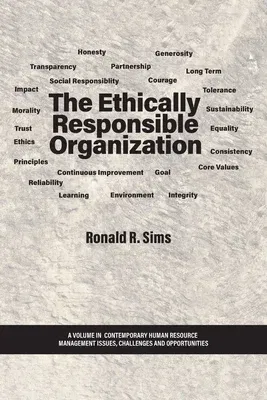Today's businesses have an obligation to conduct themselves in an
ethical and responsible manner at all times. Fortunately, many
businesses have historically embraced the idea that they can operate in
an ethically & responsible manner. However, there are way too many
companies that are willing to cut corners and do whatever it takes to
make a profit, thus contributing to the vortex of mistrust, distrust,
misinformation, disinformation and less than full disclosures as a
result of their unethical misconduct. This book takes the position that
'enough is enough' and argues that all businesses can and must be
ethically responsible no matter its size or whether it operates locally
or globally. The book describes the features of an ethically responsible
(e.g., ethical and socially responsible) organization that is committed
to always "doing the right things" which means they are committed to
building, institutionalizing and sustaining an ethically oriented
organizational culture. Ethical responsibility means maintaining -even
improving- your bottom line, while setting a high bar for high ethical
standards AND making a positive contribution to society. The book argues
that organizations must be attentive to ensuring that the culture has as
its core accountability, responsibility, and learning which means it
invests in developing and expecting all of its employees to be fully
engaged in making ethical decisions and being ethical leaders. The book
also discusses what it means to be an ethically responsible global
business, leader, middle manager, and lower-level employee.
The Ethically Responsible Organization provides a detailed look at the
importance of organizations doing preventive work to avoid ethical falls
or scandals and takes the position that if such a fall or scandal occurs
then the company should seize the moment and learn from the experience
by becoming a learning organization. The book also takes the position
that an ethically responsible organization is already a learning
organization where continuous inquiry, diagnosis, reflection, learning
and self-correction is the keystone of the way it operates. Finally, the
book offers some ideas on how organizations can reinforce and sustain
themselves as ethically responsible businesses today and in the future
by taking a strategic approach to ethics that includes constant and
consistent ethics training and education for all its employees and
partners. In the end, the purpose of the book is to continue to increase
our understanding of why organizations stray from "doing the right
things" and how a focus on being ethically responsible can position
companies to avoid or quickly respond to any potential ethical
misconduct or find themselves in the list of the years' top ethical
scandals. This book is written for all those who also take the stance
that 'enough is enough' when it comes to the headlines of another
failure because the organization's leaders would not commit to being
ethically responsible and find themselves in the throes of an ethical
scandal and unable to recover from it - and like "Humpty Dumpty, all the
kings horses and all the kings men the company can't recover from what
was a preventable ethical fall."


